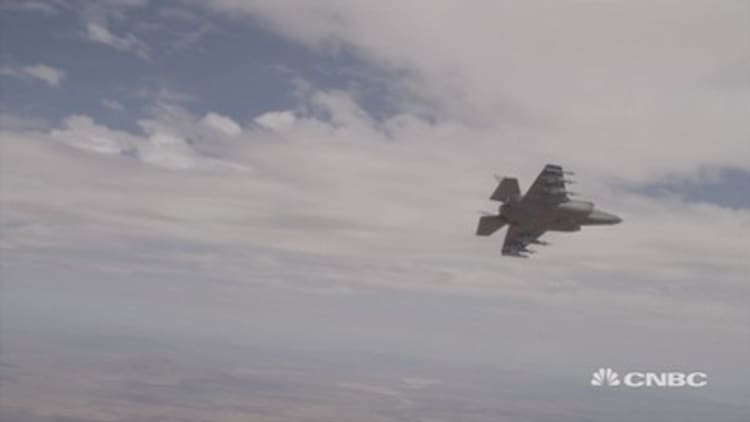
In a possible "game changer" on how the United States and its military allies wage air campaigns, the Pentagon wants to pool the refueling capabilities of Italy and other allies in order to boost the operational potential of the F-35 Joint Strike Fighter, an aircraft that has been plagued with problems but which is seeing deliveries accelerate.
"It's a quantum leap how we can fight wars with interoperability," said Joe DellaVedova, spokesman for the Pentagon's F-35 program office. With 13 countries currently involved with the F-35 Joint Strike Fighter program, interoperability between allies is critical.
As part of the effort, the U.S. Air Force has been conducting aerial refueling test flights over California with the Italian Air Force's KC-767 tanker, which is made by Boeing, and the F-35. The first tests were conducted in early August and are expected to continue for the next several weeks.
CNBC was invited aboard one of the Italian tanker's test certification flights last week and given a firsthand look at how the Lockheed Martin-built F-35 Joint Strike Fighter is refueled. The tanker flew out of Edwards Air Force Base in California's Mojave Desert, and once over the Pacific Ocean it lowered its boom to refuel the fighter. But a "technical glitch" described as "minor" led the Italian team to abort the test.
"The Italian Air Force is trying to become the first air force or first international tanker not contained in the U.S. inventory that is actually certified to refuel U.S. Air Force planes in the 70-year history of the U.S. Air Force," said Andrew Tayon, Boeing's project manager for KC-767 Tanker Support.
He said the tanker's full certification is "very, very close to being complete" and added that it was "incredibly significant because then it opens the door for not only the Italians but then the Japanese (owners of four additional KC-767 tankers) to hopefully begin refueling" of U.S. Air Force military aircraft.
Later this month, Australian aerial tankers are slated to become certified and thereby expand the reach of the allies beyond Europe to the Greater Pacific region. The Pentagon's DellaVedova said it would give the U.S. and its allies "more options, more capabilities and more flexibility to get to places and accomplish whatever mission needs to be done."
During NATO's Libyan bombing campaign in 2011, the USAF ended up providing the bulk of the in-flight refueling capabilities, despite the mission being under French and British leadership. Italy has since acquired four KC-767 tankers. Italy's tankers were reportedly utilized late last year for in-flight resupply of aircraft fighting Islamic State (ISIS) militants in Iraq.
USAF Maj. Hans Buckwalter, an F-35 test pilot and acting director of operations in the 461st Flight Test Squadron at Edwards AFB, said interoperability with allied tankers saves not just time but money since "you don't need to deploy U.S. tankers around the globe. It's a game changer as we operate as a coalition."

The F-35's primary manufacturing site is in Fort Worth, Texas, but Italy has a plant where it's building its own fighters. The Italian factory near Milan will deliver the first fighter by the end of this year. Japan, too, is preparing to build its own final assembly facility for the fighter.
Around 45 F-35 fighters are slated for delivery this year, with 19 delivered through mid-July. U.S. defense officials have previously stated at least 450 to maybe 500 aircraft would be bought under the F-35 program, from fiscal 2018 to fiscal 2020.
It's hoped that global production of the F-35 and international sales will bring down the average unit price of the tactical aircraft's three main variants.
Officials who spoke to CNBC said there's been positive momentum in the controversial F-35 program after years of testing and development delays. The F-35, which is several years behind schedule, is expected to cost upward of $1.5 trillion by the end of the 55-year life of the program.
"Today (we're) in the system design phase of the F-35," said Buckwalter. "We're about 70 percent complete. We have two years to go. So in 2017 we will be complete with this phase of the test program."
Additionally, officials said there have been "enhancements" to the F-35 pilots' helmet-mounted display systems, including a new software package that allows for more geolocation capabilities and "full war-fighting capability." The custom helmets reportedly cost about $500,000 apiece and have been plagued by problems.
"We're seeing improvement in Lockheed's costs on the F-35," said Jefferies industry analyst Howard Rubel. "It still has some bigger-picture issues. It shouldn't be the airplane (that) solves all the problems, and I think the Air Force and the Navy will come to that conclusion at some point. And we will and we do need another aircraft."


